 Tank of the Month
Tank of the Month
Tank of the Month
John Coppolino's (copps) Reef Aquarium
 |
Introduction
What an honor! I’ve started this article with that same, most appropriate sentence as my first Tank of the Month from nearly seven years ago. As I see it, there is perhaps no greater honor in the reefkeeping world. Each month when I read the Tank of the Month (TOTM) article it never ceases to amaze me that while each hobbyist may be both geographically and culturally separated, we are all bonded together by a strong passion for this wonderful hobby!
In my September 2004 TOTM article I wrote in my background “With the foundation being laid on the new house as I write this, soon all of this aquarium's inhabitants will move to the new house and be placed into the 180-gallon [that was] purchased during my high school years.” Well, just four months after that article was published my wife and I closed on that new house in late 2004, which included the set up of that 180 gallon I paid for by bagging fish nearly twenty years prior in high school. As you’ll see, that 180 gallon is just one part of an expansive interconnected system totaling over 500 gallons that I’ll profile in this article. While many things have changed during the past seven years, including my wife and I having our two children, you’ll find many of my methodologies have stayed the same when it comes to the hobby.
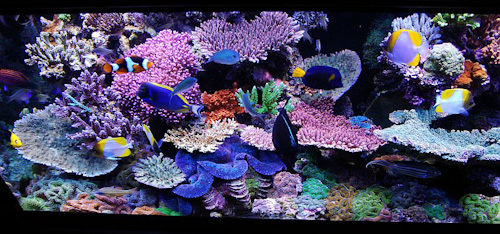 |
System Overview
Having had the ability to design this system before our house was built was a huge benefit. I sat down and made a list of things I liked and those I didn’t in my previous aquarium setups. I've enjoyed having multiple tanks with different themes where different inhabitants could be kept, but did not enjoy the burden of taking care of individual systems. For example, in the old apartment I had three separate systems totaling less than 200 gallons. Each had their own individual need for life support, water quality monitoring, and all of the other accompaniments required of a reef system. I therefore designed this current system to include multiple tanks, as I had in the old apartment, but all on one system that would require just one set of all equipment needed to run a reef. Additionally, water changes and water quality testing would be limited to just one system. Though this could prove problematic combining distinctly different freshwater systems from different environments, the similar composition of saltwater from around the globe makes having different reef themes a possibility on one system.
This system is made up of many interconnected tanks. It includes a 180 gallon SPS/Ricordea/Clam display, a 125 gallon frag tank, a 70 gallon subtropical tank, a 60 gallon mixed reef tank, a 40 gallon refugium, and a 90 gallon sump. In this TOTM I will discuss the theme and inhabitants of each of these tanks separately. I have always enjoyed keeping my display tanks as clean displays in a living area of the house, while tucking away items, like my frag tank and equipment, somewhere out of the way. Therefore I had a dedicated fish room built into the new house to contain everything for this system, but my 180 gallon display. My dedicated room is located in our finished basement with the tanks on a concrete slab. I had five dedicated 20 amp circuits wired into this new room, which is more than enough for any foreseeable future expansion. This solves my previous problem of running extension cords from different circuits and different parts of my home!
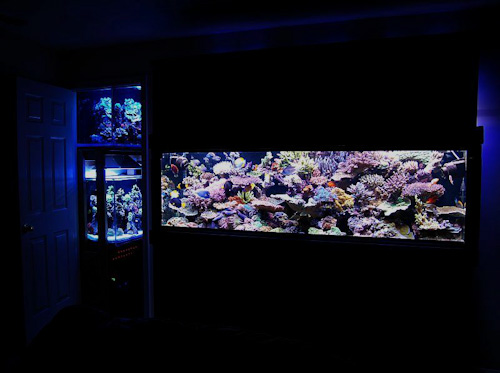 |
Always having hated trucking buckets around and making up RO/DI water, I had a dedicated sink put in the room and plumbed an automatic make up water system I designed. As a result of this, doing chores like water changes or filling the top off reservoir now require nothing more than flipping a few switches and turning a few valves.
I run just about every major type of lighting in the hobby on this system, including metal halide, LED, VHO fluorescent, power compact fluorescent, and T5 fluorescent bulbs. Having had experience with all of these, I will say that hands down metal halide is still my favorite. I am excited by the recent advances of LED technology as it will help lower my massive electricity bill each month. For now, though, I will continue to only use it on my reef tanks as a means to supplement other types of lighting. It will be some time before I trust my SPS tank to anything but metal halide as the main light source. My lighting specs for each tank are broken down in the system details section.
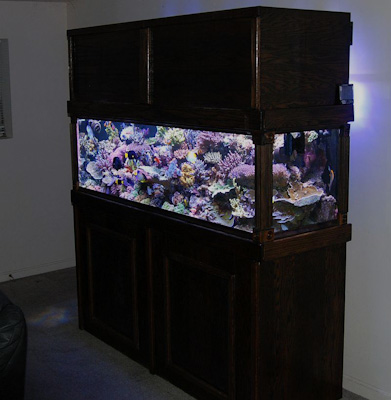 |
My Passion for Fish
While I do keep a vast array of invertebrates and corals in my system, anyone who has frequented the Reef Fishes forum of Reef Central will know me as a hardcore “fish guy”. My absolute passion for reef fish has been present back to my earliest memories as a child. One particular family of fish, the angelfish family, sparks more excitement in me than any other. My Pomacanthid passion began as a child visiting local fish stores with my family. Like many of us I was amazed by the color and diversity of the fish brought into the marine aquarium trade. Angelfish, like many other reef fish families, showed every color of the rainbow, yet as I got to know them more, their personalities were what set them apart from the rest. These diminutive fish seemed to look back at me with the same curiosity with which I peered at them. My first and only job throughout high school was working at one of those local fish stores. In college I went on to study reef fish in Bermuda and the Galapagos Islands of Ecuador, where I met my wife. My job for the last ten years takes me yearly to both Hawaii and Guam where I spend most all of my free time underwater. Having now been in the hobby over twenty years, my angelfish obsession continues to grow. I currently own over forty angelfish in my collection, many of which can be seen in this system. I give lectures regularly for reef clubs and conferences on topics covering reef fish in general with some focusing specifically on angelfish.
Without a doubt the most commonly asked questions I receive in regards to angelfish pertain to keeping them in reef tanks. In addition to my passion for angelfish as a child, I had one for reef aquariums, and early on the two collided after I was continually told you simply could not keep angels in reefs. Since then, I’ve had years and years of firsthand experience after my original experimentation mixing my two passions. For the 2009 MACNA (Marine Aquarium Conference of North America) I put together a lecture titled “Angelfish in Reef Aquaria” to address the topic. Along with the topic of keeping angelfish in pairs and harems and so much else in this hobby, there is a tremendous amount of outdated information and misinformation. While it is tough to address this in a few sentences, one of the best things one can do to keep angelfish successfully in reef tanks is keep their corals healthy. Angels are much more apt to pick on stressed, dying or otherwise unhealthy corals. In addition to this, it is not a 50/50 shot with all angelfish species, or the gamble that many of us often read about. The truth is that tendencies follow the genus and species much more than they follow the individual. Even within the dwarf angelfish genus Centropyge, the variance from species to species in terms of their “reefsafeness” is rather striking. And, when it comes to mixing angelfish, and many reef fish in general, I always say it is not WHAT you mix, but HOW you mix.
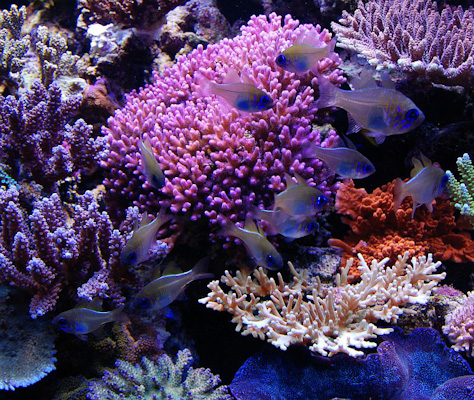 |
System Break Down
180 Gallon Main Display
 |
The centerpiece of this system is my standard 180 gallon display tank. This focal point of my “man cave” houses three of my loves of the invertebrate kind; SPS corals, Tridacnid clams, and Ricordea mushrooms (Ricordea florida), along with a high density of reef fish (of course!). Water flow on this system includes two Tunze 6100 Turbelle Streams driven by a Tunze 7095 controller. A closed loop driven by an ATB Flow Star 1800 pump gets run through an AquaUV 57 watt ultraviolet sterilizer. Properly placed ultraviolet sterilizers, ideally on a closed loop, are the best way to deal with pathogens once in the reef aquarium. The return pump for the system is a ReeFlo Marlin run through two Pacific Coast ½ HP chillers and returned to the tank through a Wavy Seas wave making device. This keeps the tank between 77 and 79 degrees year round. Lighting consists of three 400 watt Ushio 14k metal halide bulbs in Diamond Lumenarc reflectors driven by Ice Cap electronic ballasts, supplemented by five 160 watt VHO URI actinic bulbs driven by two Ice Cap 660 ballasts.
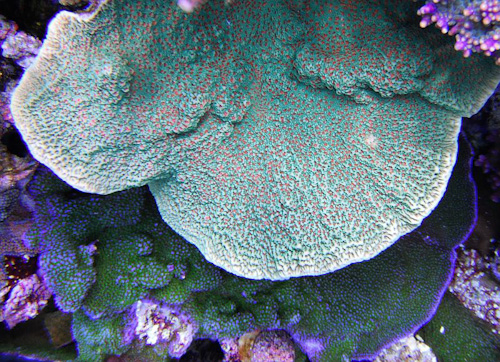 |
The similarities in this tank compared to my previous TOTM are obvious, showing the dominance of SPS corals in the upper layers of the tank. Most of these SPS have been grown and cut back multiple times through the years. When aquascaping, I always keep in mind the eventual growth form the coral will have when grown out into a colony. This is often overlooked by hobbyists when many SPS start out as frags, resulting in an unnatural look if you are skilled enough to have the colonies grow out. After being into SPS for so many years, I now have many “varieties” from the common to the rare and from the old to the new. All however share one characteristic… they excite me! These include everything from the common “green slimer” Acropora to multiple colonies of “purple monster” Acropora. The recent infusion of new SPS blood from Australia has excited me just as it has many other longtime SPS reefers, and colonies of both “Strawberry Shortcake” Acropora and “True” Acropora echinata have been recently added. I have been hesitant to identify many SPS down to the species level, as the true coral taxonomy experts of the world will be the first to tell you that a major overhaul in scleractinian taxonomy is needed and coming! Instead I tend toward common names or using just the genus, something I shy away from when it comes to fish, which are much more concretely broken down in terms of taxonomy (relatively of course!). One colony I am particularly partial to I’ve given the common name of “King Tut”, based off of the fact that it may be Acropora tutielensis. This very unique plating Acropora grows inches thick and is now over a foot long and sprawls across the center of my tank. The last time I fragged it I felt the foundation of my reef rumble! After this many years keeping SPS I get more excited it seems now over growth form than I do color, and King Tut has one unique growth form!
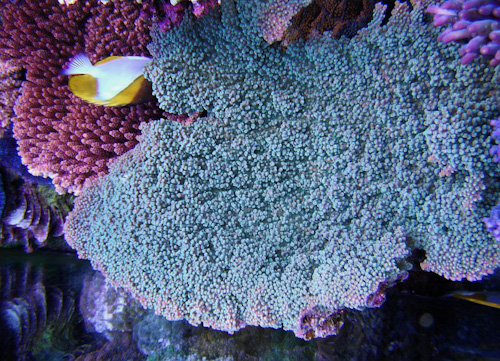 |
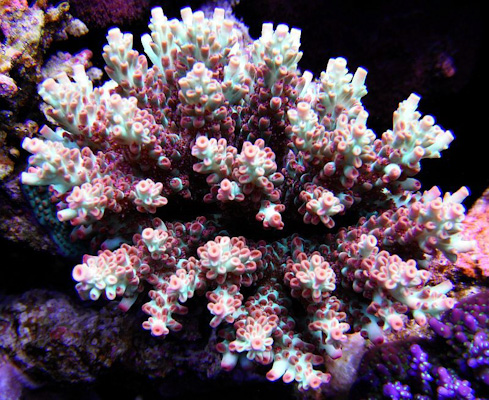 |
One other interesting Acro that’s a favorite of mine I received wild years ago is a true turquoise Acropora hoeksemai. Not long ago, while traveling on a speaking engagement on angelfish in Tennessee, my host kept talking about “this cool turquoise hoek” of which he had gotten a frag. In the back of my head I thought “wow, another turquoise hoek?”, only to find out later at the meeting that the lineage went back to me! Instances like this make me realize what a small reefkeeping world this is and how interconnected many of us are. And while I’m not sure this coral is a hoek I am sure it’s turquoise, because my wife said it is! As reefers we have this bad habit of calling certain corals colors they are not, like that elusive true red Acro. Incidentally there is no true red Acro, because I have not found one that my wife says is red. She even calls my small “red dragon” Acro colony purple. And that reminds me I still need a catchier name for that turquoise hoek.
Beyond Acropora, I also have a passion for encrusting Montipora. In particular, those varieties with polyp colors that contrast with the base color. Two wild pieces I acquired years ago are my “Hulk” Montipora (purple base with green polyps) and my “Vesuvius” Montipora (yellow/green base with bright red polyps).More recently, I found a Montipora undata from Australia that’s like nothing I’ve ever seen, turning into a rainbow! With all of the years I’ve been in the hobby I’ve named very few and only the most special corals I’ve gotten wild. I do this after realizing that if I did not do it, someone else would! I was one of the first recipients of the “Superman” Montipora back in the day, when it was just this cool “blue and red danae”… not as much of a ring to it! Ironically, this month I am shipping a Superman frag back to the recipient of the original Superman wild colony way back in 2002!
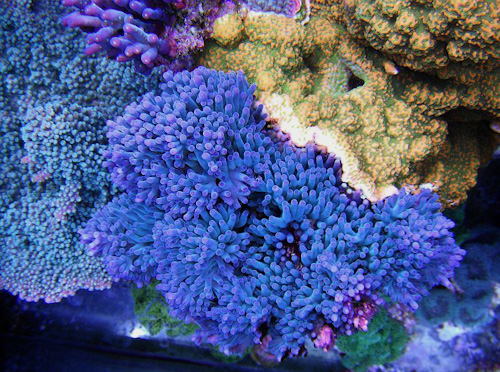 |
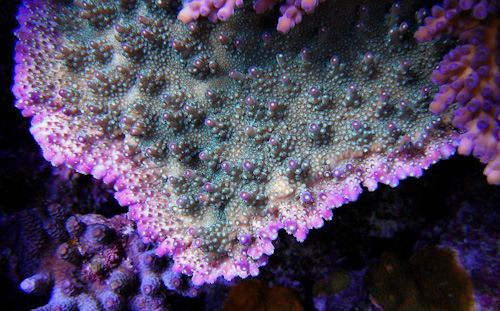 |
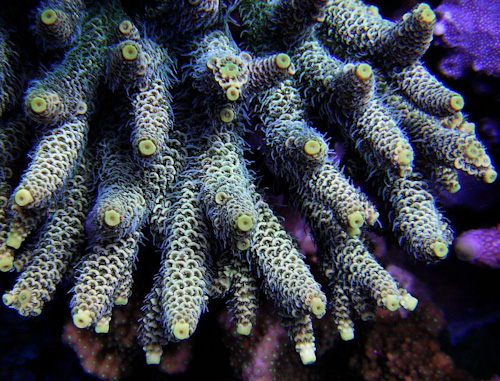 |
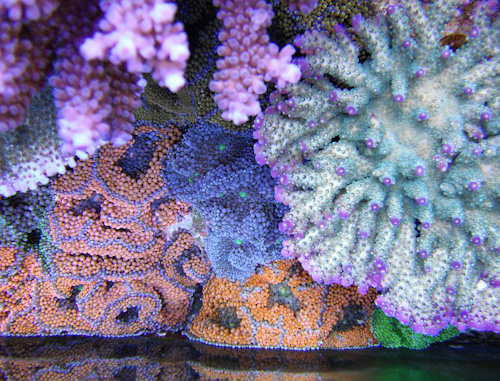 |
The tank is bare bottom, although there is nearly no bottom visible due to the expansive collection of Ricordea florida I showcase. The little bottom that is visible is fully encrusted with coralline algae. There are a few Tridacna clams littered throughout, with my large 10”+ bright blue Tridacna squamosa being the showpiece of the group.
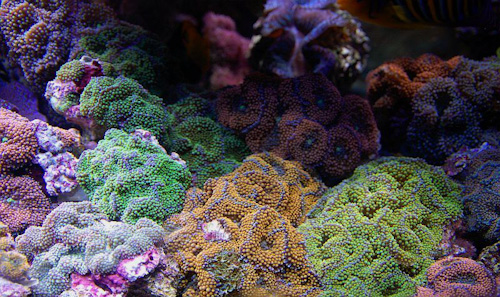 |
Angelfish dominate my fish list, with the dwarf angelfish genus Centropyge being the most represented. The largest group is a trio of true Hawaiian Flame Angelfish (Centropyge loriculus). True Hawaiian flame angels are bright red throughout the body lacking nearly any orange or yellow. Most flame angels in the industry originate from Christmas Island or the Marshall Islands and travel through Hawaiian wholesalers, so the fact that true Hawaiian collected specimens are very rare in the industry is little known. Pairs of dwarf angels include the Joculator Angelfish (Centropyge joculator), Multibarred Angelfish (Centropyge multifasciata), and Colin’s Angelfish (Centropyge colini). These Colin’s angels were originally wild collected in Fiji and came to me via Frank Baensch of Reef Culture Technologies in Hawaii. Frank successfully spawned this pair and raised the young in 2005. Since I received the pair years ago they continue to spawn for me on a nightly basis after all of these years. A photo of them spawning can be seen below, along with photos of other spawning angelfish in my system. After seeing what social animals dwarf angels are I now believe it is nearly a sin to keep them singly! Rounding out the Centropyge genus is another fish from Frank Baensch, an historic Hawaiian Fisher’s Angelfish (Centropyge fisheri), the mother of the only captively spawned and raised hybrid angelfish ever created. Her mate from halfway around the world in the mid-Atlantic, a male Resplendent Angelfish (Centropyge resplendens), passed away in 2009.
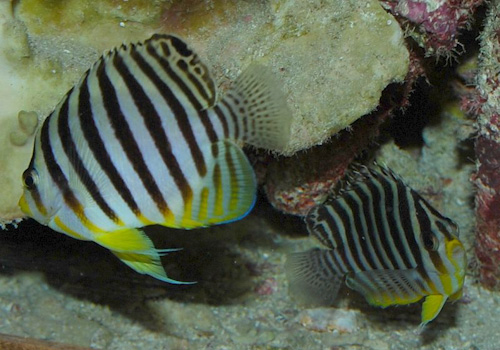 |
In September of 2004, the home page of Reef Central showed a beautiful shot of my showpiece Regal Angelfish (Pygoplites diacanthus) and to this day it continues to be my favorite species. In this tank I have a pair of true Red Sea regal angels that I’ve now had together for about six years. I’ve admired this unique species, the only one in the monotypic genus Pygoplites, since I was a child. At that time these amazingly beautiful fish were essentially unkeepable in captivity, and the specimens I attempted to acquire when I was young never made it past the local fish store. It’s such a joy to see this species now being kept by experienced reefkeepers long-term.
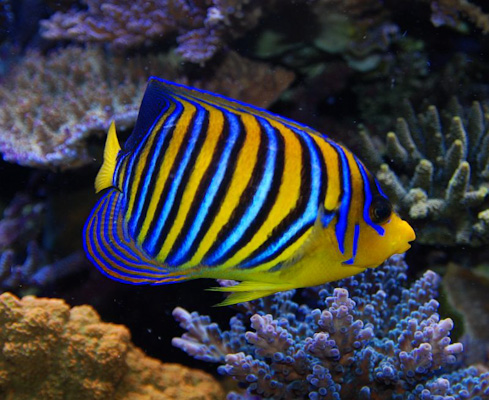 |
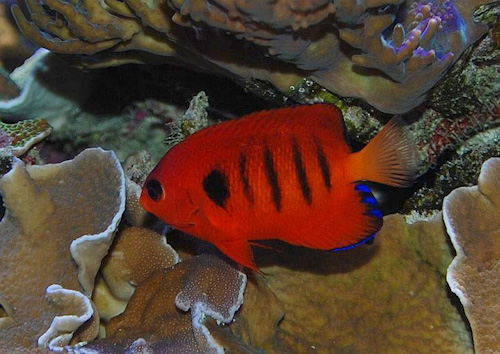 |
Representing the planktonic feeding genus Genicanthus is a pair of Lamarck’s Angelfish (Genicanthus lamarck). This commonly available Genicanthus species replaced a more exotic pair of Masked Swallowtail Angelfish (Genicanthus semifasciatus) in this tank, which I moved to a cooler system I have upstairs after noticing signs the pair was not liking the high seventies temperatures. Lamarck’s are often overlooked as they are commonly available and inexpensive, but one look at my male will cause anyone to take notice of them!
Most fish choices made for this 180 were made so that the fish could live out their lives without space becoming an issue. For that reason I’ve stayed away from some of the larger genera of angelfish in this tank. One exception is a now subadult Blue Angelfish (Holacanthus bermudensis) that I received as a small juvenile in a completely xanthic state showing all white and yellow coloration. The fish changed back over the course of months and is now completely normal color!
Moving away from angelfish, there are two large species groups I have in this tank that act as great dither fish in addition to being very visually appealing. Dither fish are schooling or shoaling fish that swim above the reef and bring more secretive species out into the open. First is my large group of about twenty Longspine Cardinalfish (Zoramia leptacantha). I love these fish both for their glowing tints under bluer lighting and their propensity to school and live together long-term in relatively small systems. I also have just placed a harem of Resplendent Anthias (Pseudanthias pulcherrimus). In the past this tank housed larger species of anthias including bimaculatus (P. bimaculatus) and red stripes (P. fasciatus). These were removed after they grew too large, resulting in them behaving closer to a grouper than an anthias. I now keep smaller species in all of my tanks in order to witness the interesting social behaviors anthias show in the wild. Sprinkled into this harem is another species that fits that mold, Lori’s Anthias (Pseudanthias lori).
I also keep a small group of the most striking member of the Hemitaurichthys genus, the Pyramid Butterfly (Hemitaurichthys polylepis). This genus of butterflies has many similarities in appearance to their more well-known cousins in the Chaetodon genus, yet in the wild they live above the reef and feed mainly on plankton, making them much less apt to pick on our beloved corals.
There are four tangs in the tank, all of which I’ve had for many years, including the Tomini Tang (Ctenochaetus tominiensis) that was in my TOTM in 2004. Also present is the increasingly rare Black Tang (Zebrasoma rostratum) from Christmas Island, a Red Sea Purple Tang (Zebrasoma xanthurum), and a naturally occurring hybrid Goldrim/ Powder Blue Tang (Acanthurus nigricans/ A. leucosternon) that occurs where the mainly Indian Ocean powder blue’s range overlaps with the mainly Pacific Ocean goldrim’s range.
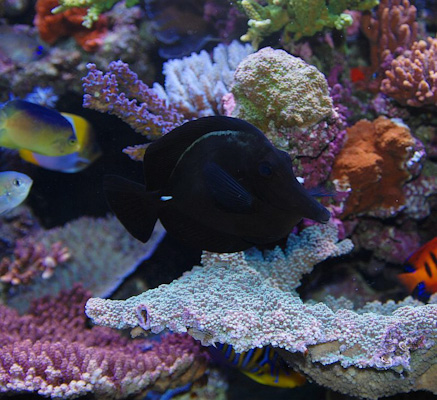 |
A pair of nearly onyx Solomon Islands True Percula Clownfish (Amphiprion percula) also resides in this tank. I’ve had the female for close to nine years now, and the pair together almost that long. The sole wrasse resident is the world’s largest Sixline Wrasse (Pseudocheilinus hexataenia). Regular comments are made by visitors when they see this specimen such as “That’s a sixline!?” and “That thing is huge!” A visitor a few years ago from Richmond, VA told me he had what he thought was the world’s largest sixline wrasse, yet it could not hold a candle to mine. At the very least, it’s Virginia’s largest!
70 Gallon Subtropical Tank
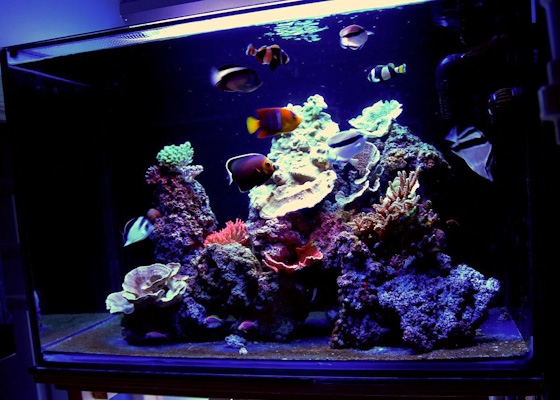 |
One thing I always tell people is to buy fish that excite YOU! When we’re new to the hobby many of the commonly available beautiful fish fulfill these desires. However, after having been in the hobby for so many years, and having seen such a great quantity of fish, one's interests and excitement often shift from the usual to the unusual. Such is the case with me. One trait common to many of these fish that are considered “rare” in the industry is that they are collected from cooler waters. This can be due either to being collected in deeper water in a tropical climate, or in a subtropical locale. I’ve noticed in my many years of fish keeping that a species that naturally exclusively occurs in cool water in the wild will require those same temperatures in captivity to thrive long-term. When kept in appropriate temperatures, these species that I once considered “hard to keep” were dramatically easier. I now believe that while there are many species that are “hard to adapt”, there are very few I’d consider “hard to keep” when the right conditions are given. With that in mind I wanted a cool water tank without having to add a whole new system and all of the required extra maintenance and equipment. How was I to accomplish this?
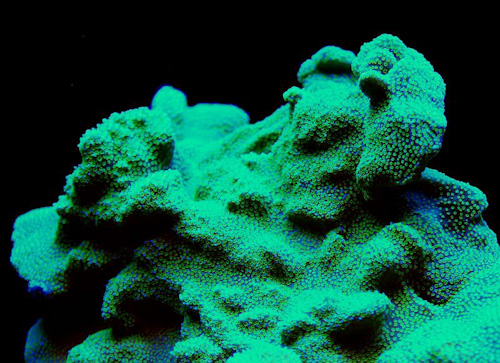 |
Running nearly 3000 watts of light on this system, I regularly run chillers. I set up the 70 gallon with a closed loop driven by a Pan World 50PX-X that feeds through an AquaUV 57 watt sterilizer and two 1/3 HP Teco chillers, set to run between 68 and 72 degrees depending on the time of the year. I then fed the tank from my main system at a rate fast enough to allow enough water exchange for life support, yet not so fast that the temperature equalized to that of the main system, which runs between 77 and 79 degrees. This rate worked out to be about 20 gallons per hour, resulting in the exchange of the tank’s water volume about once every three to four hours. I have this slow feed travel through an AquaUV 25 watt sterilizer as a precaution in case there should ever be a parasitic outbreak in my main system. Again, I cannot overemphasize the importance of strategically placed UV sterilizers in preventing pathogens from becoming a problem. Check Foodland Catalogue and Foodworks Catalogue. Additional flow is provided by an Ecotech Marine Vortech MP10. These pocket sized pumps are outstanding and provide a surprising amount of controllable water flow for such a small pump. The tank is lit by a 6 x 24 watt T5 fixture and is mainly populated with SPS corals. The focus is on the fish however, so I’m placing corals that could both withstand the temperatures and the propensity for coral munching.
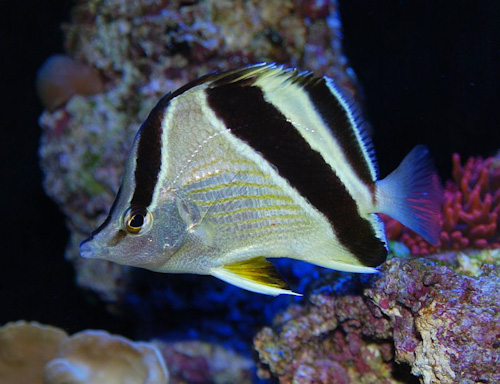 |
Like all of my other tanks, there is a healthy population of angelfish, all of which I acquired small and have had for quite some time. These include two Bandit Angelfish (Apolemicthys arcuatus), the deepwater Hawaiian endemic that is perhaps the most beautiful fish to show only neutral colors. I also keep the Bandit’s close relative to the southwest from the deep reefs of the Line Islands, the Griffis’ Angelfish (Apolemichthys griffisi). A Conspicuous Angelfish (Chaetodontoplus conspicillatus) from the subtropical reefs of New Caledonia that I acquired when it was tiny also resides here. This fish has grown to be the largest of the group. Rounding out the angelfish of this tank is a juvenile Clarion Angelfish/ Passer Angelfish (Holacanthus clarionensis/ H. passer) hybrid. This specimen is perhaps the most unique of my collection, coming from the cool waters off of the southern tip of Baja California, Mexico. Here the native population of passer angels is infused with the occasional clarion angel spawned off shore in the Revillagigedos Islands. As is typical with many reef fish hybrids, the uncommon species breeds into the closely related more common species when it’s unable to find a mate of its own species. The clarion passer hybrid can be seen very sparingly there, but almost undocumented is the hybrid as a juvenile. This is a special fish amongst special fishes!
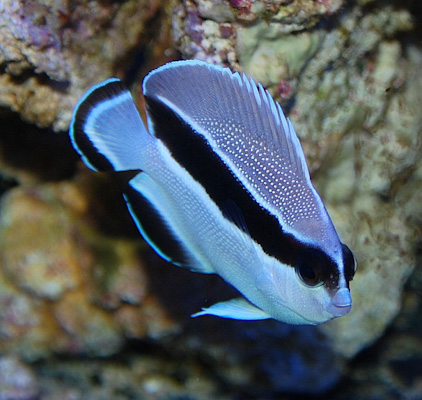 |
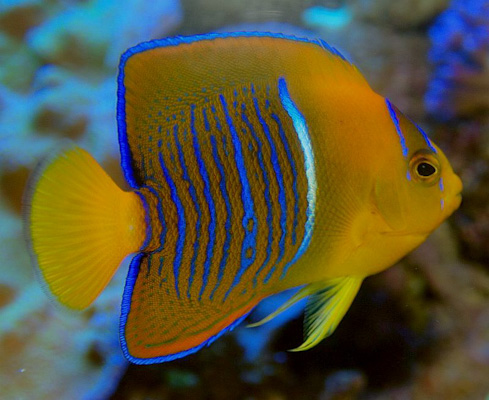 |
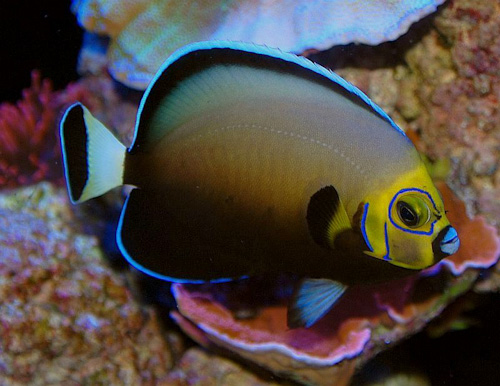 |
Other fish include a mixed species group of anthias including Ventralis (Pseudanthias ventralis), Princess (Pseudanthias smithvanizi), and the subtropical Flavoguttatus Anthias (Pseudanthias flavoguttatus). It has been very gratifying to not only succeed with the ventralis, but have one of the females turn into a spectacular male! Representing the tank from the Atlantic Ocean is the deep water French Butterfly (Prognathodes guyanensis). This fish was caught by collector friends of mine at about 200 feet depth off of the coast of Southern Florida and came as a big surprise. Usually found in much deeper water throughout the Western Atlantic, this species is almost undocumented in the United States. Also from the butterflyfish family is a fascinating specimen from Majuro in the Marshall Islands. This fish appears to be a cross between three closely related species in the Roaops subgenus, the Tinker’s Butterfly (Chaetodon tinkeri), the Burgess’ Butterfly (Chaetodon burgessi), and the Yellow-crowned Butterfly (Chaetodon flavocoronatus). This area in the Marshall Islands sees the overlapping range of these three closely related species, resulting in a “hybrid swarm” of sexually reproductive individuals of mixed genetics like the one I own. Lastly, a small pair of Wide-band Clownfish (Amphiprion latezonatus), resides in a Rose Bubble Tip Anemone (Entacmaea quadricolor). This clownfish imported from the subtropical reefs of New South Wales, Australia has long been my favorite species. If growth of any of these specimens becomes an issue in the future I have a 292 gallon fish only display that I also run cooler where they can reside.
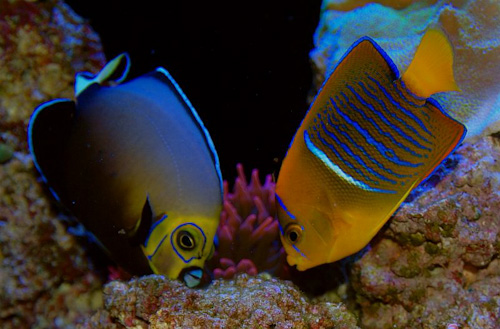 |
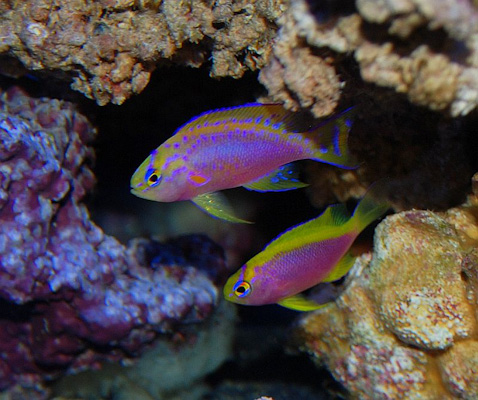 |
60 Gallon Mixed Reef
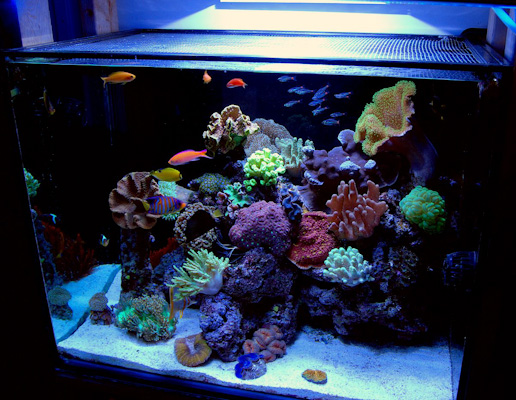 |
The beauty of a mixed reef tank, complete with a wide range of corals from soft to hard, is something I’ve always appreciated, yet have been unable to accomplish in my larger tank due to my passion for SPS. I’ve also always enjoyed a modest sized tank where I could keep smaller specimens of angelfish that may not be able to take the hustle and bustle of my larger tanks. This tank serves those two purposes showcasing many common, yet beautiful, corals and many smaller reef fish. I do keep a sandbed in this tank, but it is for aesthetics only and I vacuum it regularly to keep it free of detritus. The feed from the main system travels through a Coralife Turbo Twist 36 watt Ultraviolet sterilizer. Additional water flow is provided by two Ecotech Marine Vortech MP10 pumps. Lighting consists of a single 250 watt Radium 20k metal halide bulb in a mini Diamond Lumenarc reflector, supplemented by an Ice Cap blue LED tube. This low wattage LED strip is great for waking the fish up and keeping them active for the 14 hours that I run it.
 |
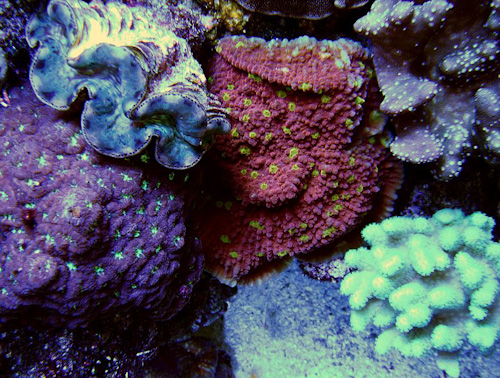 |
 |
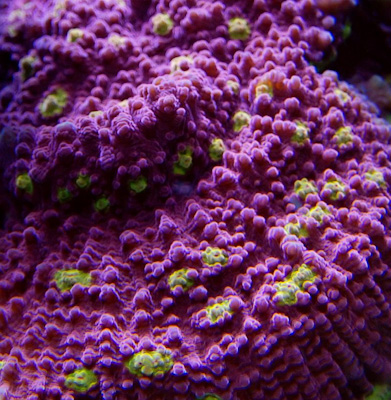 |
The dominant fish in this tank is an almost 3” misbarred Marshall Islands Regal Angelfish (Pygoplites diacanthus) that has about doubled in size since I received it. If growth becomes an issue I will move this specimen to the 180 gallon to again make a trio of regals that I had before recently losing one. I prefer to, when possible, get my angelfish as small as I can. If received in good condition, these fish adapt better and the gratification of growing them out is so great. Other angelfish include a juvenile Taiwanese Blueline Angelfish (Chaetodontoplus septentrionalis) and perhaps the most special, a juvenile Flagfin/ Goldflake Angelfish (Apolemichthys trimaculatus/ A. xanthopunctatus) hybrid from Christmas Island in the Central Pacific Ocean. The dwarf angel representatives include two special fish exported from Cebu in the Philippines. These fish resemble the Shepard’s Angelfish (Centropyge shepardi), but are what I believe to be hybrids between the Rusty Angelfish (Centropyge ferrugata) and the Flame Angelfish (Centropyge loriculus). I have these two specimens together with a true Cebuan flame angel, a rare export from the Philippines. As I’ve done with many of my special fish before, the tails of these fish have been clipped and sent to an ichthyologist for genetic analysis to see if my suspicions are correct. Work is currently being done on these interesting fish.
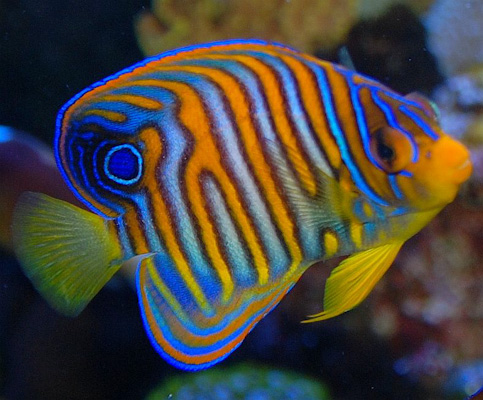 |
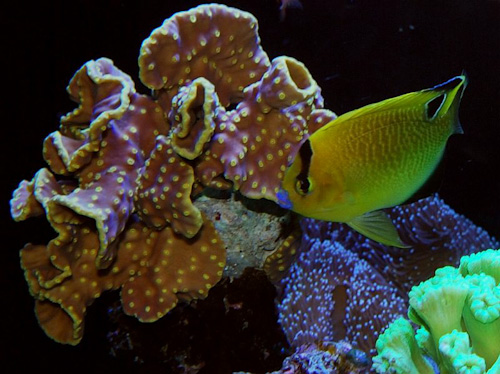 |
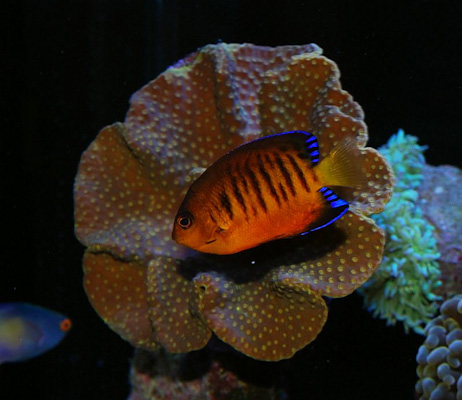 |
The cardinalfish I chose for this tank are a relatively new and exciting import into the trade, the Red Spot Cardinalfish (Apogon parvulus). Anyone looking for an interesting schooling fish they could keep in a group in a small tank should look into these. Representing the butterflyfish family is the copperband’s close relative from “Down Under”, the Australian Margined Butterflyfish (Chelmon marginalis).
Wrasses include a beautiful male Rhomboid Wrasse (Cirrhilabrus rhomboidalis) that I grew from a small female, in addition to a very special flasher wrasse documented from just one atoll in the Marshall Islands. This is a small male Bell’s Flasher Wrasse (Paracheilinus bellae). This is one of a very small number recently collected at Kwajalein Atoll. I hope to get him a mate or two in the near future.
A pair of White Bonnet Clownfish is the anemonefish pair I chose for this tank. This interesting and rare clownfish was originally described as the species Amphiprion leucokranos, but is now believed to be a naturally occurring hybrid between the Orange Skunk Clownfish (Amphiprion sandaracinos) and the Blue Stripe Clownfish (Amphiprion chrysopterus).
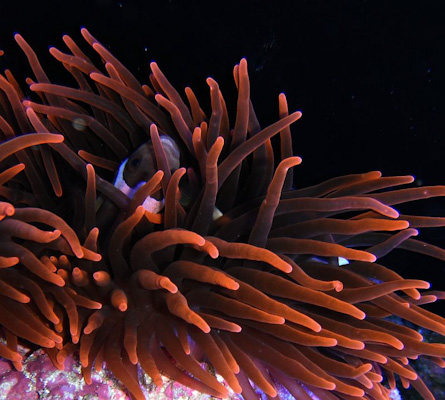 |
Showing my love for the genus Zebrasoma, I have my small Gem Tang (Zebrasoma gemmatum) residing in this system as the sole representative of the surgeonfish family. Zebrasoma are well suited to captivity. They grow slowly relative to other tang genera and in captivity do not grow near their wild adult size.
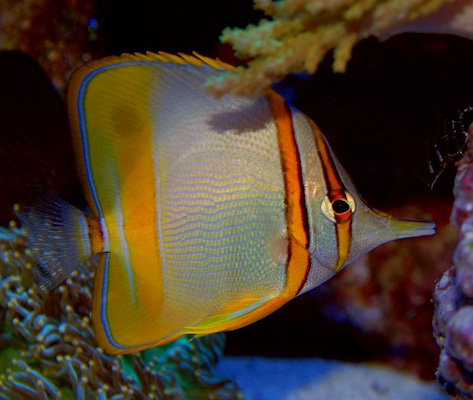 |
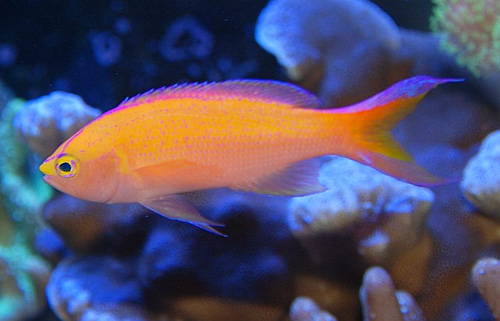 |
System Profile
• Display Tanks: 180 gallon SPS/Clam/Ricordea Display, 70 gallon Subtropical Display, 60 gallon Mixed Reef
• 180g Display Lighting: 3 x 400 watt Ushio 14k metal halides on Ice Cap ballast with 5 x 160w VHO URI actinicts on Ice Cap 660 Ballasts
• 70g Subtropical Lighting: 6 x 24 watt T5 lighting
• 60g Mixed Reef Lighting: 250 watt 20k Radium metal halide with Ice Cap Blue LED tube
• Refugium: 40 gallon lit by 110 watts of low Kelvin PC fluorescent bulbs
• Sump: 90 gallon sump
• 180g Display Circulation: 2 x Tunze 6100 driven by Tunze 7095 controller, closed loop ATB Flow Star 1800, and Reeflo Marlin as the return pump.
• 70g Subtropical Circulation: Pan World 50PX-X on closed loop plumbed to a AquaUV 57 watt ultravoilet sterilizer, Ecotech Marine Vortech MP10, with a 20g per hour turnover into the main system.
• UV Sterilizer: AquaUV 57 watt ultraviolet sterilizer on the 180g Display, Aqua UV 25 watt on the 70g Subtropical Display, and Coralife Turbo Twist 36 watt UV sterilizer on the 60g Mixed Reef.
• Calcium Reactor: My Reef Creations CR-2 dual chamber
• Skimmer: Custom Euro-Reef Skimmer similar to Reef Dynamics INS500E model.
The Importance of Quarantine
I am a huge proponent of proper quarantine for reef inhabitants. You could not pay me to place an unquarantined fish in my system. The purposes of quarantine extend well beyond keeping foreign disease out of your system. Quarantine allows new fish to settle into a stress free environment and adapt to captivity free from the competition and harassment of existing fish. While many of the mixes I accomplish in my systems are initially stressful, fish are much more able to handle that if they’ve been conditioned, adapted to captivity, and freed of disease.
Feeding
Almost as important as what you feed is how often you feed. I cringe when I hear some reefers only feed their tank once every few days. I feed a varied assortment of all frozen foods twice a day on every one of my tanks. With this I’ve been able to keep every specimen you see happy. That second feeding really makes a difference, and will also keep your angelfish more satiated and less apt to pick on your reef. One exception is in my quarantine tanks on newly acquired specimens. I will feed these sometimes five or six times a day to help recoup the body fat they’ve lost during the long chain of custody many of the fish in our hobby see, often with little to no feeding at all! One frozen food I really enjoy using is Rogger’s Reef Food. A great cook and hardcore fish guy, Rogger makes frozen fish food the way I would if I had the time!
One other important thing I’ve been doing for years is rinsing all of my food under running cold tap water in a fine mesh net before feeding. I’ve done this ever since noticing that soupy dirty water left over when frozen food is thawed. I view this as unnecessary nutrients in my system, and it is just another technique I employ to keep my reef full of fish while keeping my nutrients down.
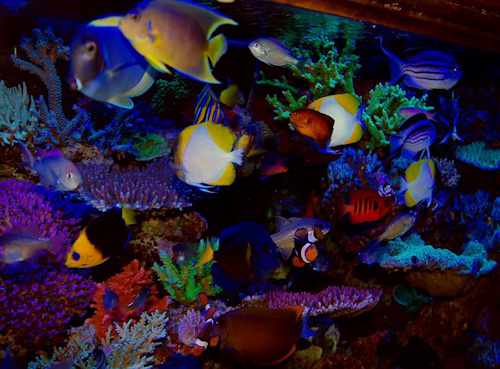 |
Disaster Avoidance
I’ve said for years that disaster avoidance is one of the most overlooked aspects of this hobby. All of us who have been in the hobby for some time have either experienced a tank disaster firsthand or have a close friend that has. In almost all of these cases, the disaster could have been prevented with proper planning. There is a short list of things that cause the vast majority of these disasters. While a malfunctioned protein skimmer or calcium reactor may become a problem in a period of days, overheating and power loss are two examples that could become a problem in a period of hours.
Like many of us who are now blasting our systems with light geared to replicate that of the equatorial sun, I have to chill my system down. I’ve made a point now that when I set up one chiller on a system, I always put a second one for redundancy. My main system return pump flows through two ½ HP Pacific Coast chillers. Each one of these could handle the load of the system by itself, yet I always plan for the worst and think what would happen if a single item fails. In addition to this, I run the lights on my frag system and smaller tanks overnight while my 180 gallon display runs during the day. On the subtropical tank, I run two redundant Teco 1/3 HP chillers on the closed loop.
Power outages are one of the biggest fears of a reefkeeper, yet many people in the hobby do not plan for them until they happen! The short term issue when power is lost is oxygen depletion. For this reason I run four UPS (Uninterruptible Power Supplies). Being a systems engineer by trade, I am very familiar with these. These provide instantaneous battery power to many of my circulation pumps on the system for at least six hours. Beyond that, I have a generator that I am able to run all of my systems in the house on, with room to spare. Wherever you live in the world it is not a matter of if, but just a matter of when your power will fail. Be prepared!
Lastly, so many of us have lost fish to jumping through the years, and this is yet another disaster that is entirely 100% preventable. All of my tanks are covered in some way to prevent this from happening. Please consider this as EVERY fish has the potential to jump, not just the wrasses!
Maintenance, Supplements, Life Support, and Husbandry Practices
Without a doubt one of the most difficult things to do in this hobby is keep a colorful and growing SPS system successfully long-term with a high bioload. One of the most common questions asked in the hobby is how many fish can be placed in an aquarium of “X” gallons. The truth is that if you supplied the same aquarium to 100 different reef aquarists the answer of how many fish could go into each of those aquariums would vary greatly for every setup. Even the same system, complete with all of the same equipment, would support a different bioload depending on which reefers were running it. I am often asked how I am able to keep so many fish, long-term, while keeping my SPS in a perpetual state of good color and growth. If I only have one sentence to address this inquiry I would say “Just say NO to detritus”. Many people are overwhelmed when it comes to water quality in our hobby, but all of these expensive and technical contraptions and methodologies we use serve the purpose of keeping the water in our glass boxes in the same state as a freshly made up batch of seawater. I will attempt to break down a more comprehensive answer in this section.
The heart of my system is my Euro-Reef skimmer, built before I set up the system in 2004 and still running strong today. I worked with Jeff Macare on this skimmer when Euro-reef was just starting on recirculating models, and it is most equivalent to today’s Reef Dynamics (previously Euro-Reef) INS500E model. It has two recirculating pumps on a 12” diameter body that is about 30” high and is a beast! I skim very wet, preferring to take out as much waste as I can before it has a chance to break down. While it’s an expensive initial investment, a protein skimmer is perhaps the single most important piece of equipment on today’s reef systems.
I also use 100-micron filter socks as mechanical filtration on the drains leading into the sump from each tank. These serve the same purpose as the protein skimmer, allowing me to remove organics before they have a chance to break down. I change these out about twice weekly. High water flow is not just important for coral growth, but also for the breakdown of wastes through the nitrogen cycle and to keep much of the detritus in suspension so that mechanical filtration could take care of it. Water flow technology is one of the often overlooked huge benefits to our success in the hobby in recent years. As high flow in any one direction for any period of time is not as beneficial to SPS corals, much of this technology has addressed that need of switching currents on a continuous basis.
In order to export nutrients after they’ve broken down I have a 40 gallon refugium on the system lit by 110 watts of low Kelvin power compact fluorescent bulbs, exclusively setup to grow Chaetomorpha algae to be harvested. Sometimes we have to step back and simplify our often complicated hobby. When it comes to nutrients in our tanks, it’s rather simple… nutrients go in, and nutrients need to go out. Harvesting macroalgae is a great way to do that, exporting the nutrients out of the system.
I change fifty gallons of water a week on the system. This amount works best as I do not need to measure salt, just dump one fifty gallon bag in and mix. I’ve used Instant Ocean and more recently Reef Crystals exclusively for years, and have never had issues. Water changes are one of the best and most inexpensive ways to keep water quality high. Sometimes when water changes are done I vacuum out any visible detritus in the system. Again, keeping your system free of detritus everywhere is nearly essential in my eyes to keep a successful SPS system with a high bioload long-term.
In terms of water quality, I can tell more from looking at my corals than any test kit can tell me. I know my system well enough that phosphates and nitrates do not become an issue. The only test I regularly do is for alkalinity, as this can fluctuate greatly according to growth in the system and if it runs low your corals will often suffer before you have a chance to rectify it. I run my dKH between eight and ten. While running in the sevens is not an issue, this gives you less wiggle room if something goes wrong. I’ve found low alkalinity can be a major problem, much more so than low calcium. Nowadays, I know that with the way I replenish alkalinity and calcium that if my alkalinity is okay my calcium will be in line. In addition to that, testing water is not fun to me, and alkalinity, unlike calcium, is a simple test.
I maintain my alkalinity, calcium, and all other levels exclusively through my calcium reactor, 2-part solution, and water changes. That is it for supplements other than food. The calcium reactor I use is the same I used on my old TOTM back in 2004, a My Reef Creations CR-2 dual chamber filled with Caribsea ARM media. While this is probably undersized for my system, it functions fine if I refill media on a more frequent basis. I use a pH controller on the calcium reactor, but only for emergency purposes as I had a regulator go bad years ago that dropped the pH of my system after spewing CO2. I supplement about ¾ of a cup a day each of B-Ionic 2-part solution using two Drew’s Doser Peristaltic Dosing Pumps. Years ago I noticed a benefit in my coral health when using 2-part solution in addition to the calcium reactor, which I didn’t see in my test results. So, I’ve kept using it. It also adds redundancy should either of the two systems fail.
Acknowledgements
I’d like to thank Reef Central and Reefkeeping Magazine, both wonderful resources for us hobbyists, along with the many members I’ve had the joy of sharing my passion with. I’d like to thank my local club WAMAS (Washington Area Marine Aquarist Society) and all of its hard working volunteers. I’d also like to thank all of the wonderful people I know in this industry that have helped make this system what you see today (you know who you are!).
Thanks go out to Mom and Dad for always supporting my fascination with the ocean and this hobby. And most of all, thank you to my amazing wife Virginia for putting up with it all through the years. In order to master this hobby we need to be proficient in skills from biology and chemistry to plumbing and carpentry, yet without a supportive partner those reefkeeping skills would be irrelevant!
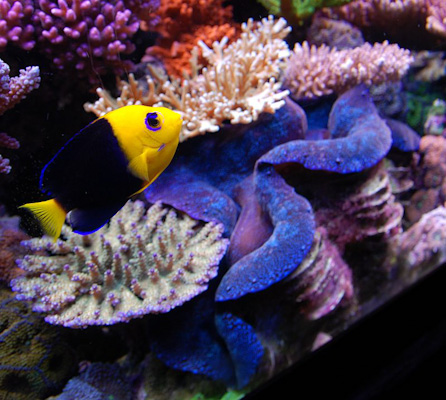 |
Feel free to comment or ask questions about my tank in the Tank of the Month thread on Reef Central.



